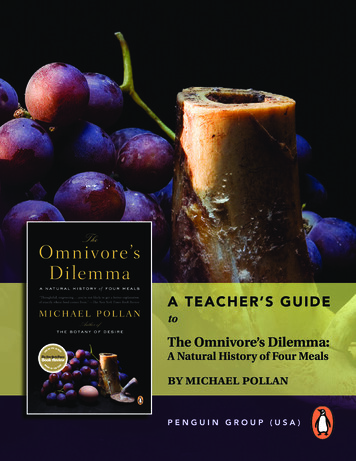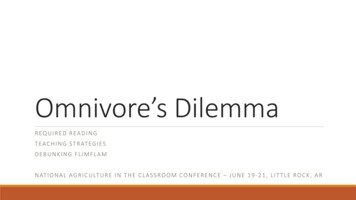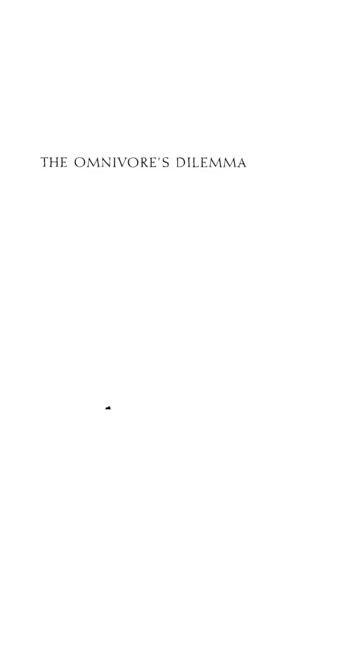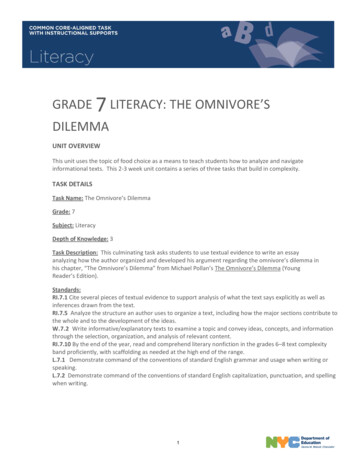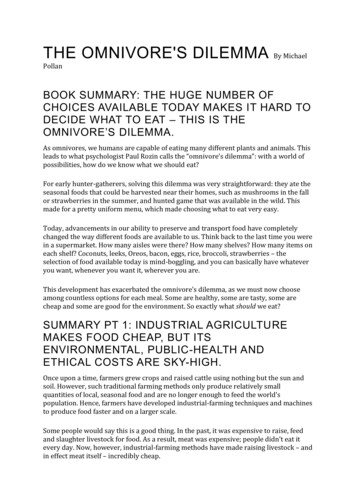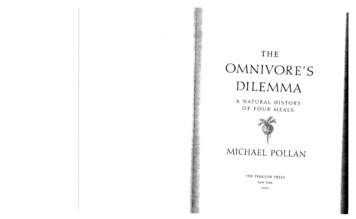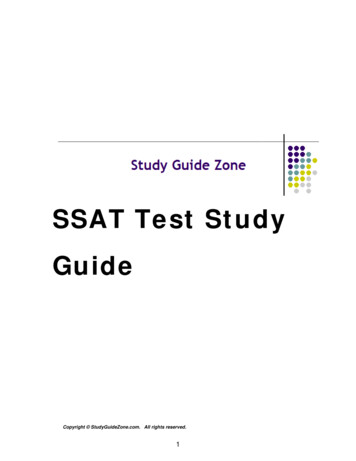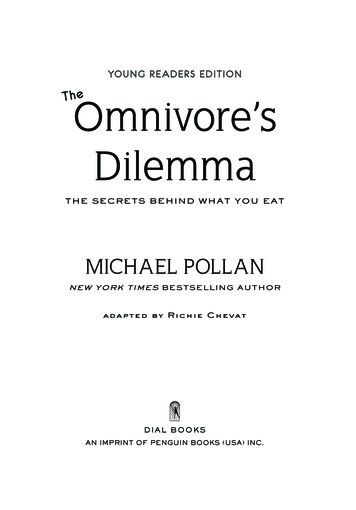
Transcription
Yo u n g R e a d e r s E d i t i o nTheOmnivore’sDilemmaTHE SECRETS BEHIND WHAT YOU EATMICHAEL POLLANNEW YORK TIMES BESTSELLING AUTHORadapted by Richie ChevatDial Booksan imprint of Penguin Books (USA) Inc.9780803734159 OmnivoresDil TX 1-314.indd 13/5/10 2:55:33 PM
DIAL BOOKSAn imprint of Penguin Group (USA) Inc.Published by The Penguin GroupPenguin Group (USA) Inc., 375 Hudson Street, New York, NY 10014, U.S.A.Penguin Group (Canada), 90 Eglinton Avenue East, Suite 700, Toronto, Ontario,Canada M4P 2Y3 (a division of Pearson Penguin Canada Inc.)Penguin Books Ltd, 80 Strand, London WC2R 0RL, EnglandPenguin Ireland, 25 St. Stephen’s Green, Dublin 2, Ireland (a division of Penguin Books Ltd)Penguin Group (Australia), 250 Camberwell Road, Camberwell, Victoria 3124, Australia(a division of Pearson Australia Group Pty Ltd)Penguin Books India Pvt Ltd, 11 Community Centre, Panchsheel Park,New Delhi-110 017, IndiaPenguin Group (NZ), 67 Apollo Drive, Rosedale, North Shore 0632, New Zealand(a division of Pearson New Zealand Ltd)Penguin Books (South Africa) (Pty) Ltd, 24 Sturdee Avenue, Rosebank,Johannesburg 2196, South AfricaPenguin Books Ltd, Registered Offices: 80 Strand, London WC2R 0RL, EnglandCopyright 2009 by Michael PollanAll rights reservedThe publisher does not have any control over anddoes not assume any responsibility for author or third-party websites or their content.Book design by Jasmin RuberoText set in Calisto MTPrinted in the U.S.A.1 3 5 7 9 10 8 6 4 2Library of Congress Cataloging-in-Publication DataChevat, Richie.The omnivore’s dilemma : the secrets behind what you eat/by MichaelPollan;adapted by Richie Chevat.—Young readers ed.p. cm.ISBN 978-0-8037-3415-91. Food supply—Juvenile literature. 2. Food chains(Ecology)—Juvenile literature. I. Pollan, Michael. Omnivore’s dilemma.II. Title. III. Title: Secrets behind what you eat.HD9000.5.C506 2009338.10973—dc2220090092839780803734159 OmnivoresDil TX 1-314.indd 23/5/10 2:55:33 PM
For Judith and Isaac9780803734159 OmnivoresDil TX 1-314.indd 33/5/10 2:55:33 PM
9780803734159 OmnivoresDil TX 1-314.indd 43/5/10 2:55:33 PM
Ta ble of Content sIN T RODUCT ION. . 1PA RT IT HE INDUST R I A L ME A L:FOOD F ROM COR N12123456789How Corn Took Over America. 9The Farm. 20From Farm to Factory. 29The Grain Elevator. 40The Feedlot—Turning Corn into Meat. 47Processed Food. 64Fat from Corn. 76The Omnivore’s Dilemma. 85My Fast-Food Meal. 97PA RT IIT HE INDUST R I A L ORGA NIC ME A L1210 Big Organic. 11111 More Big Organic. 127PA RT IIIT HE LOCA L SUSTA INA BL E ME A L:FOOD F ROM GR A SS1212 Polyface Farm. 14313 Grass. 1519780803734159 OmnivoresDil TX 1-314.indd 53/5/10 2:55:33 PM
14151617The Animals. 161The Slaughterhouse. 171The Market. 182My Grass-Fed Meal. 193PA R T I VT HE DO-I T-YOUR SEL F ME A L:HUN T ED, GAT HER ED, A ND gardened FOOD121819202122The Forest. 205Eating Animals. 215Hunting. 231Gathering. 247The Perfect Meal. 263A F T ERWOR D: VOT E W I T H YOUR FOR K. 277T HE OMNI VOR E’S SOLU T ION:SOME T IP S FOR E AT ING. 285Q&A W I T H MICH A EL POL L A N. 291F UR T HER R ESOURCES. 299ACK NOW L EDGMEN T S. 303SOURCES. 307INDE X. 3279780803734159 OmnivoresDil TX 1-314.indd 63/5/10 2:55:33 PM
TheOmnivore’sDilemma9780803734159 OmnivoresDil TX 1-314.indd 73/5/10 2:55:33 PM
9780803734159 OmnivoresDil TX 1-314.indd 83/5/10 2:55:33 PM
IntroductionBefore I began working on this book, I never gave much thoughtto where my food came from. I didn’t spend much time worrying about what I should and shouldn’t eat. Food came from thesupermarket and as long as it tasted good, I ate it.Until, that is, I had the chance to peer behind the curtain ofthe modern American food chain. This came in 1998. I wasworking on an article about genetically modified food—foodcreated by changing plant DNA in the laboratory. My reporting took me to the Magic Valley in Idaho, where most of thefrench fries you’ve ever eaten begin their life as Russet Burbankpotatoes. There I visited a farm like no farm I’d ever seen orimagined.It was fifteen thousand acres, divided into 135-acre cropcircles. Each circle resembled the green face of a tremendousclock with a slowly rotating second hand. That sweepingsecond hand was the irrigation machine, a pipe more than athousand feet long that delivered a steady rain of water, fertilizer, and pesticide to the potato plants. The whole farm wasmanaged from a bank of computer monitors in a control room.19780803734159 OmnivoresDil TX 1-314.indd 13/5/10 2:55:33 PM
m ich a e l p ol l a nSitting in that room, the farmer could, at the flick of a switch,douse his crops with water or whatever chemical he thoughtthey needed.One of these chemicals was a pesticide called Monitor, usedto control bugs. The chemical is so toxic to the nervous systemthat no one is allowed in the field for five days after it is sprayed.Even if the irrigation machine breaks during that time, farmers won’t send a worker out to fix it because the chemical isso dangerous. They’d rather let that whole 135-acres crop ofpotatoes dry up and die.That wasn’t all. During the growing season, some pesticidesget inside the potato plant so that they will kill any bug thattakes a bite. But these pesticides mean people can’t eat the potatoes while they’re growing, either. After the harvest, the potatoesare stored for six months in a gigantic shed. Here the chemicalsgradually fade until the potatoes are safe to eat. Only then canthey be turned into french fries.That’s how we grow potatoes?I had no idea.A Burger With Your Fries?A few years later, while working on another story, I foundmyself driving down Interstate 5, the big highway that runsbetween San Francisco and Los Angeles. I was on my way tovisit a farmer in California’s Central Valley. It was one of thosegorgeous autumn days when the hills of California are gold.Out of nowhere, a really nasty smell assaulted my nostrils—thestench of a gas station restroom sorely in need of attention. ButI could see nothing that might explain the smell—all aroundme were the same blue skies and golden hills.29780803734159 OmnivoresDil TX 1-314.indd 23/5/10 2:55:33 PM
in t roduct ionAnd then, very suddenly, the golden hills turned jet-blackon both sides of the highway: black with tens of thousandsof cattle crowded onto a carpet of manure that stretched asfar as the eye could see. I was driving through a feedlot, withtens of thousands of animals bellying up to a concrete troughthat ran along the side of the highway for what seemed likemiles. Behind them rose two vast pyramids, one yellow, theother black: a pile of corn and a pile of manure. The cattle,I realized, were spending their days transforming the stuff ofone pile into the stuff of the other.This is where our meat comes from?I had no idea.Suddenly that “happy meal” of hamburger and fries lookeda lot less happy. Between the feedlot and the potato farm, I realized just how little I knew about the way our food is produced.The picture in my head, of small family farms with white picketfences and red barns and happy animals on green pastures, wasseriously out of date.The Omnivore’s DilemmaNow I had a big problem. I went from never thinking aboutwhere my food came from to thinking about it all the time. Istarted worrying about what I should and shouldn’t eat. Justbecause food was in the supermarket, did that mean it wasgood to eat?The more I studied and read about food the more I realized I was suffering from a form of the omnivore’s dilemma.This is a big name for a very old problem. Human beings areomnivores. That means we eat plants, meat, mushrooms—justabout anything. But because we are omnivores we have very39780803734159 OmnivoresDil TX 1-314.indd 33/5/10 2:55:33 PM
m ich a e l p ol l a nlittle built-in instinct that tells us which foods are good for usand which aren’t. That’s the dilemma—we can eat anything,but how do we know what to eat?The omnivore’s dilemma has been around a long time. Buttoday we have a very modern form of this dilemma. We havea thousand choices of food in our supermarkets, but we don’treally know where our food comes from. As I discovered,just finding out how our potatoes are grown might scare youoff french fries for the rest of your life.In the past, people knew about food because they grew itor hunted it themselves. They learned about food from theirparents and grandparents. They cooked and ate the same foodspeople in their part of the world had always eaten. ModernAmericans don’t have strong food traditions. Instead we havedozens of different “experts” who give us lots of differentadvice about what to eat and what not to eat.It’s one thing to be crazy about food because you like toeat. But I found I was going crazy from worrying about food.So I set out to try to solve the modern omnivore’s dilemma. Idecided to become a food detective, to find out where our foodcomes from and what exactly it is we are eating. My detectivework became the book you now hold in your hands.Four MealsAs a food detective, I had to go back to the beginning, to thefarms and fields where our food is grown. Then I followed iteach step of the way, and watched what happened to our foodon its way to our stomachs. Each step was another link in achain—a food chain.A food chain is a system for growing, making, and deliver49780803734159 OmnivoresDil TX 1-314.indd 43/5/10 2:55:33 PM
in t roduct ioning food. In this book, I follow four different food chains. Eachone has its own section. They are:IndustrialThis is where most of our food comes from today.This chain starts in a giant field, usually in theMidwest, where a single crop is grown—corn, orperhaps soybeans—and ends up in a supermarketor fast-food restaurant.Industrial OrganicThis food is grown on large industrial farms,but with only natural fertilizers, and natural bugand weed control. It is sold in the same way asindustrial food.Local SustainableThis is food grown on small farms that raiselots of different kinds of crops and animals.The food from the farm doesn’t need to beprocessed, and it travels a short distance—to afarmer’s market, for example—before it reachesyour table.Hunter-GathererThis is the oldest type of food chain there is. It’shardly a chain at all, really. It is made up simplyof you, hunting, growing, or finding your food.All these food chains end the same way—with a meal. And soI thought it important to end each section of the book with a59780803734159 OmnivoresDil TX 1-314.indd 53/5/10 2:55:34 PM
m ich a e l p ol l a nmeal, whether it was a fast-food hamburger eaten in a speedingcar, or a meal I made myself from start to finish.the PleAsures oF eAtingWhen I was ten years old, I started my own “farm” in a patchof our backyard. From that age until now, I have always had avegetable garden, even if only a small one. The feeling of beingconnected to food is very important to me. It’s an experiencethat I think most of us are missing today. We’re so confusedabout food that we’ve forgotten what food really is—the bountyof the earth and the power of the sun captured by plants andanimals.There were parts of this book that were difficult to write,because the facts were so unpleasant. Some of those factsmight make you lose your appetite. But the point of this bookis not to scare you or make you afraid of food. I think we enjoyfood much more if we take a little time to know what it is we’reputting in our mouths. Then we can really appreciate the trulywonderful gifts that plants and animals have given us. To me,that’s the point of this book, to help you rediscover the pleasures of food and learn to enjoy your meals in a new way.69780803734159 OmnivoresDil TX 1-314.indd 63/5/10 2:55:34 PM
the meal:source: McDonald’seaten: In the carmeNu:Classic cheeseburgerLarge friesLarge Coke (32 oz.)art istockphoto.com/pablohPA R T Ithe industrial meal:Food from Corn9780803734159 OmnivoresDil TX 1-314.indd 73/5/10 2:55:34 PM
9780803734159 OmnivoresDil TX 1-314.indd 83/5/10 2:55:34 PM
1How Corn Took Over AmericaA Field Of CornThe average supermarket doesn’t seem much like a field ofcorn.Take a look around one. What do you see? There’s a large,air-conditioned room. There are long aisles and shelves piledhigh with boxes and cans. There are paper goods and diapersand magazines. But that’s not all. Look again. Somewhere,behind the brightly colored packaging, underneath the labelscovered with information, there is a mountain of corn.You may not be able to see it, but it’s there.I’m not talking about the corn in the produce section. That’seasy to recognize. In the spring and summer, the green ears ofcorn sit out in plain view with all the other fruits and vegetables.You can see a stack of ears next to the eggplants, onions,apples, bananas, and potatoes. But that’s not a mountain ofcorn, is it?Keep looking. Go through produce to the back of the supermarket and you’ll find the meats. There’s corn here too, but99780803734159 OmnivoresDil TX 1-314.indd 93/5/10 2:55:34 PM
m ich a e l p ol l a nit’s a little harder to see. Where is it? Here’s a hint: What didthe cows and pigs and chickens eat before they became cuts ofmeat? Mainly corn.Go a little further now. There’s still a lot of corn hiding inthis supermarket. How about those long aisles of soft drinks?Made from corn. That freezer case stuffed with TV dinners?Mostly corn. Those donuts and cookies and chips? They’remade with a whole lot of corn.Supermarkets look like they contain a huge variety of food.The shelves are stuffed with thousands of different items. Thereare dozens of different soups and salad dressings, cases stuffedwith frozen dinners and ice cream and meat. The range of foodchoices is amazing.Yet if you look a little closer, you begin to discover:It’s All Corn.Well, maybe not all corn, but there’s still an awful lot of ithiding here—a lot more than you suspect. We think of oursupermarkets as offering a huge variety of food. Yet most of thathuge variety comes from one single plant. How can this be?Corn is what feeds the steer that becomes your steak.Corn feeds the chicken and the pig.Corn feeds the catfish raised in a fish farm.Corn-fed chickens laid the eggs.Corn feeds the dairy cows that produce the milk, cheese,and ice cream.See those chicken nuggets in the freezer case? They are reallycorn wrapped up in more corn. The chicken was fed corn. Thebatter is made from corn flour. The starch that holds it togetheris corn starch. The oil it was fried in was corn oil.But that’s not all. Read the label on any bag of chips, candybar, or frozen snack. How many ingredients do you recognize?109780803734159 OmnivoresDil TX 1-314.indd 103/5/10 2:55:34 PM
t he indust r i a l me a lMaltodextrin? Monosodium glutamate? Ascorbic acid? What arethose things? What about lecithin and mono-, di-, and triglycerides?They are all made from corn. The golden food coloring? Madefrom corn. Even the citric acid that keeps the nugget “fresh” ismade from corn.If you wash down your chicken nuggets with almost anysoft drink, you are drinking corn with your corn. Since the1980s almost all sodas and most of the fruit drinks sold inthe supermarket are sweetened with something calledhigh-fructose corn syrup.Read the label on anyhIddeN corNprocessed food, and corn isEver look at the ingredient list on awhat you’ll find. Corn is infood label and wonder about thosethe non-dairy creamer andstrange names? All of these commonthe Cheez Whiz, the frozeningredients and hundreds more areyogurt and the TV dinner,made from corn:the canned fruit and theketchup. It’s in the candy,modified starchthe cake mixes, the mayonunmodified starchnaise, mustard, hot dogs andglucose syrupbologna, the salad dressingsmaltodextrinand even in some vitamins.ascorbic acid(Yes, it’s in a Twinkie too.)crystalline fructoseThere are some forty-fivethousand items in the averlactic acidage American supermarketMSGand more than a quarter ofcaramel colorthem now contain corn. Thisxanthan gumgoes for the non-food itemsas well—everything from119780803734159 OmnivoresDil TX 1-314.indd 113/5/10 2:55:35 PM
m ich a e l p ol l a ntoothpaste and cosmetics to disposable diapers, trash bags, andeven batteries.Corn is in places you would never think to look. It’s in thewax that coats the other vegetables in the produce section.It goes into the coating that makes the cover of a magazineshine. It’s even part of the supermarket building, because thewallboard, the flooring, and many other building materials aremade with corn.CArBon From CornYou are what you eat, it’s often said. If this is true, then whatwe are today is mostly corn. This isn’t just me being dramatic—it’s something that scientists have been able to prove. How dothey do this? By tracing the element carbon as it goes from theatmosphere into plants, then into our food, and finally, intous.You may have heard the expression that humans are acarbon-based life form. (This always seems to come up in science fiction movies, but it’s true.) Like hydrogen and oxygen,carbon is an element, one of the basic building blocks of matter. All the molecules that make up our cells—carbohydrates,proteins, and fats—contain the element carbon.All of the carbon in our bodies was originally floating in theair, as part of a carbon dioxide molecule. Plants take the carbonout of carbon dioxide and use it to make food—carbohydrates.They do this through a process called photosynthesis. Inphotosynthesis, plants use the energy of the sun (photo meanslight) to synthesize (make) food.All of our food, in fact almost all life on earth, can be traced129780803734159 OmnivoresDil TX 1-314.indd 123/5/10 2:55:35 PM
t he indust r i a l me a lPhotosyNthesIsCsuNonbradioxideO xy g e nCarbohyd rat e sW at e rAll food begins with the process of photosynthesis.back to photosynthesis in plants. It’s more than a figure ofspeech to say that plants create life out of thin air.So the plants take carbon and make it into food. Then weeat the plants, or we eat animals that have eaten the plants.That’s how the carbon winds up in our cells. But not all carbonis the same. Corn uses slightly different types of carbon thanother plants. So by looking at the type of carbon in our cells,scientists can tell how much corn we have been eating.Todd Dawson, a biologist at the University of California,Berkeley, has done exactly that kind of research. He says thatwhen you look at the carbon in the average American’s cells,“we look like corn chips with legs.”Americans don’t think of themselves as corn eaters. Ourbread is made from wheat flour. We don’t eat a lot of corn on139780803734159 OmnivoresDil TX 1-314.indd 133/5/10 2:55:36 PM
m ich a e l p ol l a nthe cob. When we think of serious corn eaters, we often thinkof people in Mexico. About 40 percent of their calories comedirectly from corn, mostly in the form of corn tortillas. YetAmericans have more corn in our diet than Mexicans. It’s justthat the corn we eat wears many different disguises.How did corn take over America? It’s really a tremendoussuccess story—for corn, anyway. Corn has managed to becomethe most widely planted crop in America—more than 80 million acres of farmland are planted with corn every year. Todayit covers more acres of the country than any other living species, including human beings. It has pushed other plants andanimals off the American farm. It has even managed to push alot of farmers off the farm. (I’ll explain that one later.) Corn isnow one of the most successful plants on earth.It’s important to remember that while humans use plantsand other animals, it’s not a one-way street. Plants and animalsdon’t just sit around waiting for human beings to use them—they use us, too. The ones that can adapt use our farms andcities to spread and multiply. Corn became king of the farmand the supermarket because it adapted itself easily to the needsof farmers and food makers. It had qualities that human beingsprized. Those qualities allowed it to spread and grow until itworked its way into every corner of our lives—and every cellin our bodies.The Rise of maizeWhen Columbus returned to Spain after his first voyage hedescribed many wonderful things he had seen to Queen Isabella.One of his discoveries was a towering grass with an ear as thickas a man’s arm, to which grains were “affixed in a wondrous149780803734159 OmnivoresDil TX 1-314.indd 143/5/10 2:55:36 PM
t he indust r i a l me a lmanner and in form andsize like garden peas, whitecorN or maIZe?when young.” That grasswas called maize, but todayMaize is the other name for whatAmericans call corn. It is the namewe know it as corn.the Spanish learned from the NativeCorn began as a wild grassAmericans who grew it. In Englandcalled teosinte. (Teosinteand much of the world, the plant ismeans “mother of corn” instill called maize.the Native American lanCorn was the English word forguage Nahuatl.) Teosinteany sort of grain, even a grain of salt.still grows wild in some(That’s where the term “corned beef”places in Central America,comes from.) The English who settledbut if you saw it, you mightin North America called the plantnot recognize it as theIndian corn, meaning Indian grain.Today, in the united States and Canmother of corn. Teosinteada, corn has become so important, itears are no bigger than yourhas taken over the word. Corn is justthumb. They are not coveredcorn, and all those other grains havein thick husks. The kernelsto stick to their own names.are tiny seeds. Yet longbefore Columbus arrived,that wild grass had managed to evolve into maize and spread across North America.Corn spread because it could adapt to the needs of humanbeings. Of course, it needed human help. Humans selected bigger ears with fatter kernels and planted those seeds. By the year700, Indians as far away as New England and Canada farmedmaize. Corn had begun its march to world domination, but itstill had a long way to go.After Columbus, the Native Americans were conqueredby the Europeans. But maize, or corn, had no loyalties to theMaya and other people who had helped it spread. It was only159780803734159 OmnivoresDil TX 1-314.indd 153/5/10 2:55:36 PM
m ich a e l p ol l a nconcerned with its own survival. The Europeans presented away for corn to spread even farther. The plant quickly adaptedto the new humans and their needs.The first thing corn did was push aside the European cropsthe new settlers brought with them. The European plants justcouldn’t compete. For example, wheat brought from Europe didnot do as well as the native maize. A seed of wheat might, withluck, yield 50 new grains of wheat. A single planted corn seedcould yield 150 to 300 fat kernels. Corn won that contest easily.Corn continued quickly to win over the new settlers by beingvery useful. It could supply them with a ready-to-eat vegetable,a storable grain, a source of fiber, an animal feed, and heatingfuel. Corn could be eaten fresh off the cob or dried on the stalk,stored over the winter and ground into flour. Corn could alsobe mashed and fermented to make beer or whiskey.the sPread aNd traNsFer oF corNthesPread oFthecorNthrouGhout the WorldthrouGhoutWorld.us maP detaIl700 AD200 AD15001000after 1500AD600BC92after 141500s AADADADDADorIGIN(5000900Teosinte originated in Central America,evolved into maize, and spread acrossNorth America by 700. Europeancolonists then spread corn across theworld.mid-1600sBC)16901500BC1750ADADADSources: The Natural History Museum, London, and Smith, C. Wayne (Ed.) Corn: Origin, History,Technology and Production. John Wiley & Sons.9780803734159 OmnivoresDil TX 1-314.indd 163/5/10 2:55:38 PM
No part of the biggrass went to waste. Thehusks could be woveninto rugs and twine. Theleaves and stalks madegood feed for livestock.The shelled cobs couldeven be stacked by theouthouse and used as arough substitute for toilet paper!In the competition forking of the crops, cornleft the European plantsin the dust. Settlers whostuck to the Old Worldcrops often perished.The colonists who recognized corn’s usefulnessdid well. And of course,one thing the successfulfarmers did was plantmore corn, helpingmaize to build its kingdom. Corn helped thecolonists and the colonists helped corn.Corn made itselfuseful in one otherimportant way. It turnedWhy corN Needs PeoPleWild teosinte does not look like modern corn. It does not have fat earswith hundreds of kernels wrapped ina thick husk. Instead, it has a singlerow of triangular seeds growing on asingle stalk. Its kernels are coveredin a hard shell. The seeds are spreadby animals.Some time several thousand yearsago, teosinte mutated or changed. Themutation made its seeds grow on acob, covered by a husk. Now its seedscould not come loose by themselves.Luckily, a creature came along thatknew how to pick those husks, takeout the seeds, and plant them. Thatcreature was us. Humans took theears off the plant, separated the kernels, ate some and planted others.Teosinte gave up its independence,but it gained an ally who helped itspread across the globe. Ever since,corn and human beings have beenjoined together. The plant cannot livewithout us. Can we live without theplant?TEOSINTE9780803734159 OmnivoresDil TX 1-314.indd 17MODERN CORN3/5/10 2:55:41 PM
m ich a e l p ol l a nout that corn was an excellent way to store and trade wealth.Dried corn is easy to transport and almost indestructible. Thefarmer can take any surplus to market and sell or trade it. In thenew colonies corn often took the place of money.Corn allowed farming settlements to become trading settlements. Corn made the slave trade possible. Traders in Africapaid for slaves with corn and then fed slaves corn when theywere brought here. Corn was the perfect plant for the growingeconomy of the colonies. And just as important, the new colonists gave corn a way to get to the rest of the world.M. Pollan, Food DetectiveOnce I realized how much of our food is made from corn, Ibegan to look at supermarkets differently. Instead of a giantvariety of food, I saw corn hiding in every aisle. Now, I havenothing against corn. There’s nothing more delicious than aroasted ear of fresh sweet corn. But I didn’t understand whythere had to be corn in everything we eat. Who decided thatcorn would be our main food? How did that happen? Wheredid all this corn come from and how did it take over our supermarket?So I decided to find out. And like any good detective, I realized I had to start at the very beginning, which in this casemeant a field of corn in Iowa. I began with that field and triedto trace the corn as it traveled across the country, first to mysupermarket and then to my stomach. I watched it being turnedinto meat, milk, and eggs by cows and chickens. I watched asit was torn apart and rebuilt into all the different foods andproducts listed on all those labels.What I discovered was a vast industry—a giant agricul189780803734159 OmnivoresDil TX 1-314.indd 183/5/10 2:55:41 PM
t he indust r i a l me a lture business or agribusiness. This industry doesn’t look muchlike farming the way most people imagine it. It’s more like aseries of factories that turn raw materials into food products.It’s a giant food chain, the one that supplies most of the foodAmericans eat today.A food chain in nature helps us understand who eats what(or whom). But the food chain that feeds most Americans isanything but natural. The industrial food chain that suppliesour supermarkets stretches thousands of miles and has dozensof different links. It’s a chain that’s powered by oil and gasolineand controlled by giant corporations. It’s a chain that separatesus from our food and keeps us from knowing what it really iswe’re eating.Most of all, it’s a food chain built around one plant. Somehow,that small wild grass that started in the hills of Central Americahas become the star of the biggest, most expensive food chainin the history of the world. But if corn is the star of this story, isit the hero or is it the bad guy? Before I could decide, I neededto get to know it better. And so I went to see it where it lives, inthe vast cornfields of the Midwest.199780803734159 OmnivoresDil TX 1-314.indd 193/5/10 2:55:41 PM
Omnivore’s Dilemma THE SECRETS BEHIND WHAT YOU EAT MICHAEL POLLAN NEW YORK TIMES BESTSELLING AUTHOR adapted by Richie Chevat DIAL BOOKS AN IMpRINT Of pENGUIN BOOKS (USA) INC. 978
